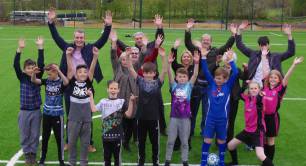What's the next $100m idea for social good?
Attendees at the Asian Venture Philanthropy Network conference in Hong Kong this week can find out how to attract the big bucks to their innovative ways of addressing social challenges.
When we were scanning the programme for the Asian Venture Philanthropy Network(AVPN) conference that is taking place in Hong Kong presently, one of the many intriguing debates on offer leapt out at us. It’s called ‘Identifying the next $100m idea for social good’. The session will be lead by Rachel Korberg, who is a senior associate at The Rockefeller Foundation (RF), the 39th biggest philanthropic foundation in the US, which gives more than $100m of grants to good causes annually. It’s a tantalising queston; with all the many deserving causes and associated organisations offering innovative solutions to challenges, how do the people with their hands on the purse strings choose who to support?
Korberg’s job is to work that out. She works within a team of five people and tells me that she currently has 436 options for investment in her database. The ideas come via several streams. As Korberg will be doing at the AVPN conference, she runs workshops in different global locations to see what people come up with.
She says that attendees at the workshops differ but that’s good for the foundation: “The idea is to really hear from people who may not be connected to the foundation in other ways to really make sure that we are listening and getting the pulse of so many different communities whether that’s social entrepreneurs in India or street organisers in Thailand for example.”
This is part of what the RF calls ‘horizon scanning’: looking for the ideas that they might eventually invest in. The foundation also uses some data science which scans content from relevant sources. With so many pressing problems in the world what they’re looking for is some early signals of change and innovation. The foundation can then harness that momentum and catalyse it in partnership with others in the space.
Starting with around 80 of the ideas, what follows is a whittling down to about three to five ideas that the team will commit to really learning about over four months. The research and development that follows takes six months and if a commitment is made it will be a two to seven year commitment. Korberg says that typically the whole process will take seven years “from when you get that first kernel of an idea to when you exit a space.”
Foundations have risk capital and can often takes risks that other organisations cannot take
The Rockefeller Foundation does not typically install someone on the board to ensure the money is spent wisely and Korberg suggests that this is because the organisations are usually very capable. For example, it has worked with Starbucks on youth unemployment and agricultural companies on food waste.
The foundation has an in-house monitoring and evaluation (M&E) team to assess impact of investments and has also invested in other M&E organisations in Asia and Africa to make better use of knowledge on the ground: "There’s a model in the past of someone flying in with a suitcase to assess a programme and in reality that’s not the best way to measure impact.”
When asked to name a favourite investment Korberg cites the intervention the foundation was able to make during the Ebola outbreak a couple of years ago. “Foundations have risk capital and can often takes risks that other organisations cannot take. One of the things we were able to do was come in at a moment when the emergency response funding was starting to dry up and a lot of the recovery funding was not yet online.”
The RF also worked with BRAC microfinance, providing some capital to use to think about how some of the recovery funding could reimagine operations. “Our goal in that case was what we called a resilience dividend, not just surviving an emergency, not just building back up the structures that caused some of the vulnerabilities from the start but using that situation to imagine and create a more long term structure.”
For more information about the AVPN conference, click here.
Photo credit: 401(K) 2012



